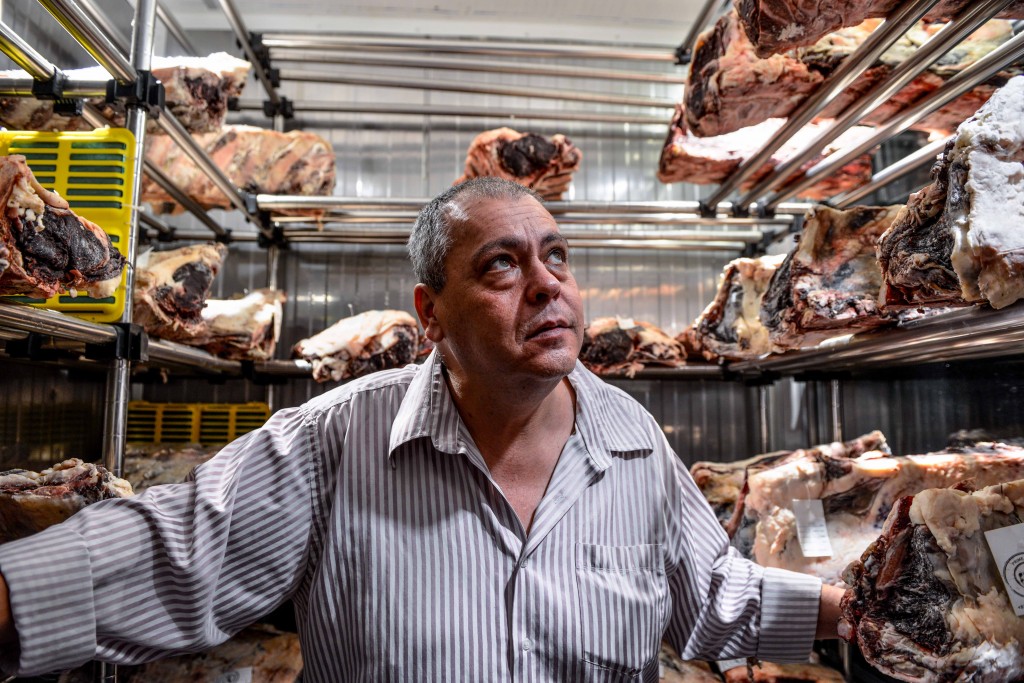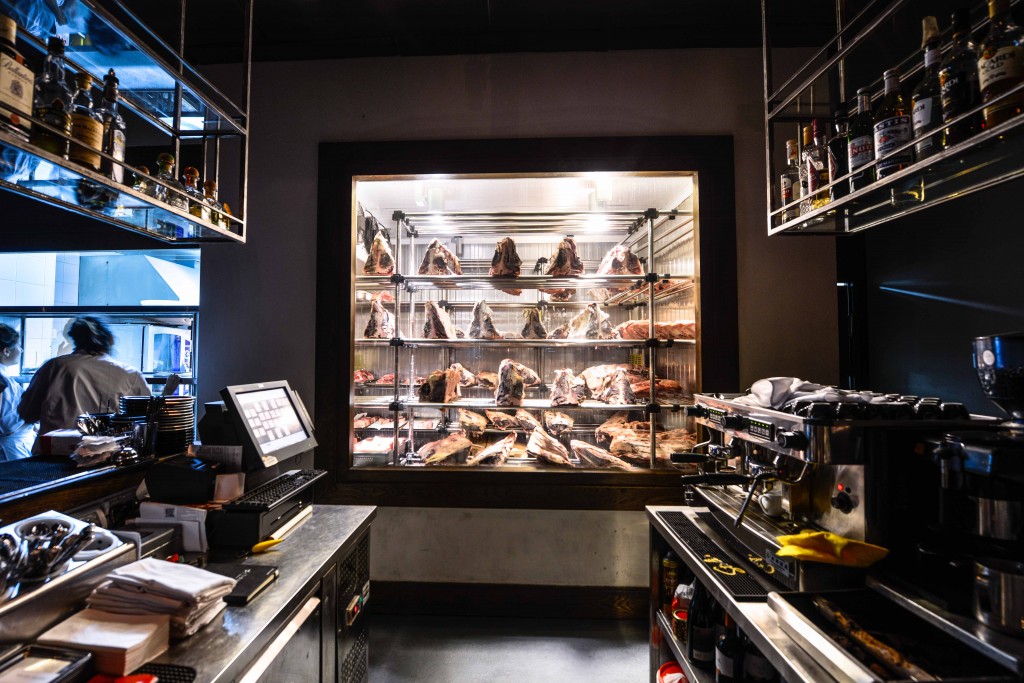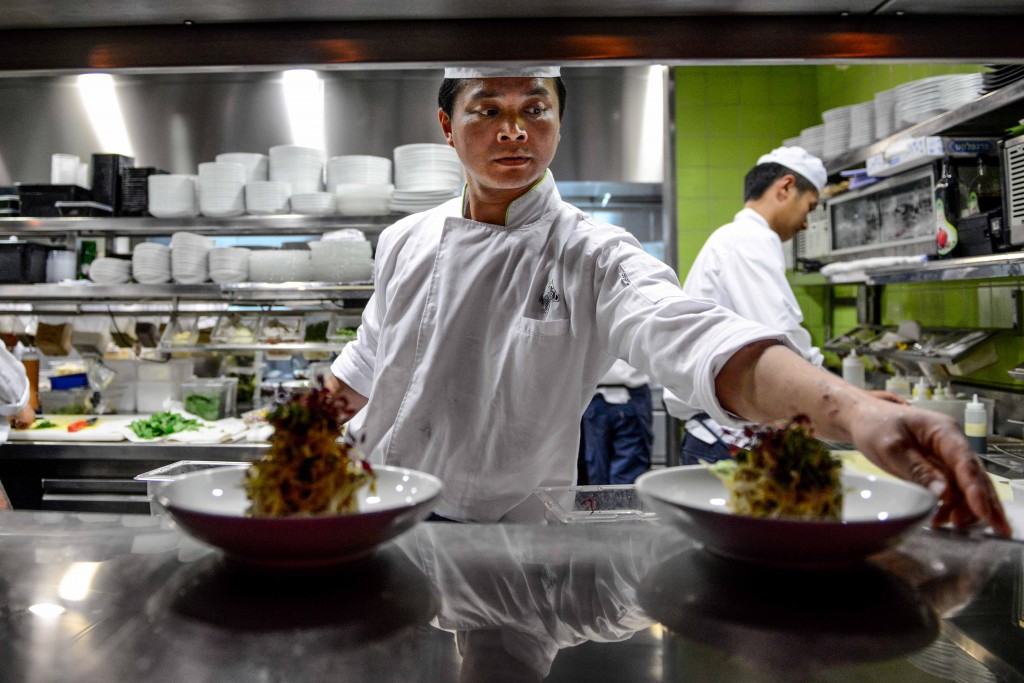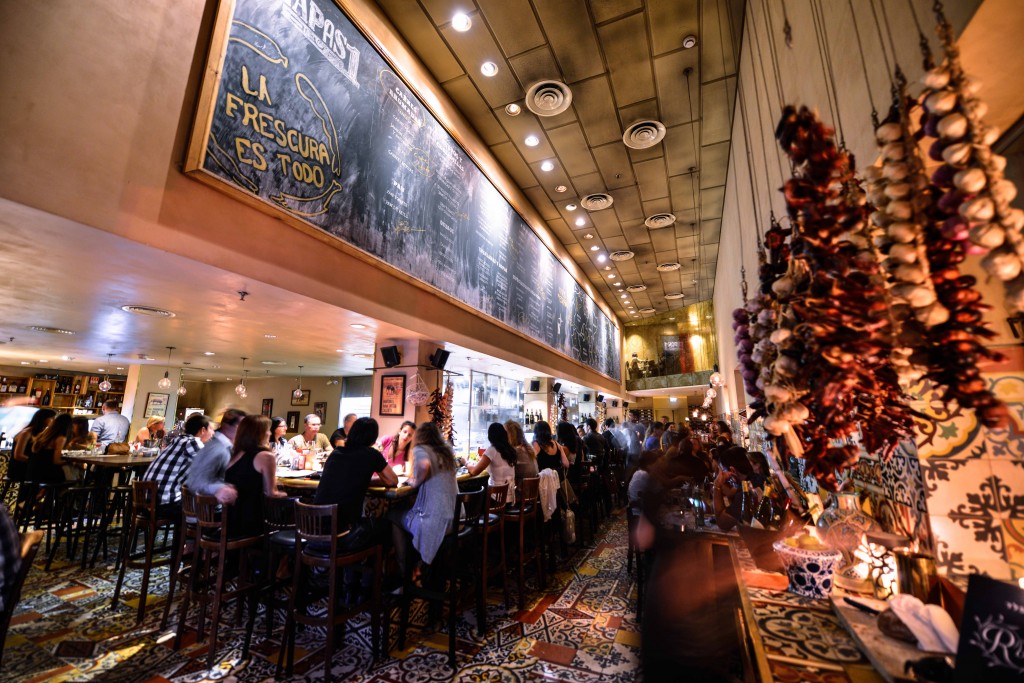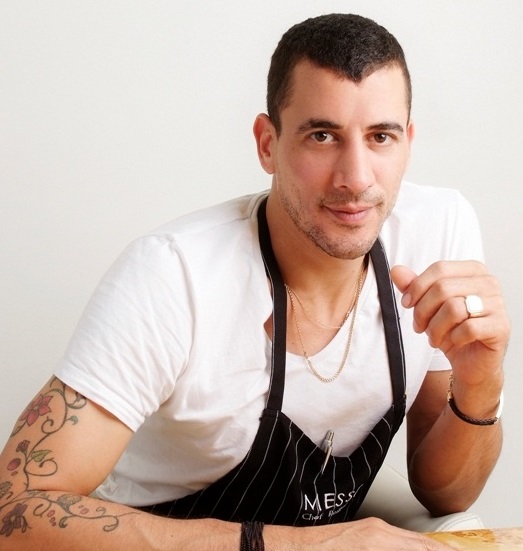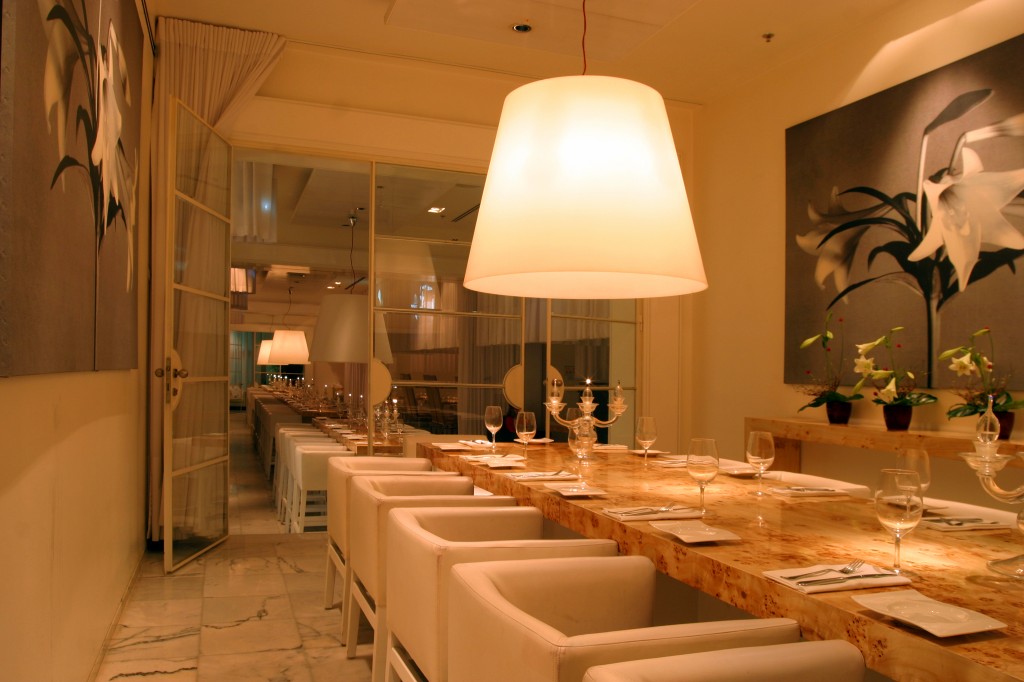How did Tel Aviv become one of the best restaurant towns in the world? The city’s top chefs reveal their long struggle and fiercely creative spirit. Photos: Aviram Valdman
When it sprang up as a garden-suburb for the bourgeoisie of Jaffa, Tel Aviv had none of the fine tastes and frenetic energy that inspire all the breathless praise today. Even before the Holocaust brought a wave of immigrants stamped by the horrors of starvation, Tel Aviv’s sensibilities mixed hope with remorse and uncertainty—not an ideal aperitif. In her 1935 poem, “Tel Aviv,” Lea Goldberg asked, “How could the air of the small city/Support so many childhood memories,/Loves that were shed, that were stripped somewhere?”
But Tel Aviv has found a way of holding all the memories–in part by forgetting itself in pleasure. And with good reason: In 2012, Condé Nast Traveler named it one of the 14 best cities for architecture, while Lonely Planet called it one of the 10 best party cities in the world. In 2013, National Geographic ranked it among the top 10 beach cities in the world and, in 2011, an American Airlines competition ranked Tel Aviv the world’s best “gay city.”
Now the attention is turning to food. Though Anthony Bourdain’s recent visit to Jerusalem, which kicked off the second season of his show Parts Unknown, made headlines, Tel Aviv’s rise as a global food hotspot has been in full swing for the past few years.
“Israel in general is at the height of a culinary revolution that started in the past decade and has been exploding ever since,” says Janna Gur, author of The Book of New Israeli Food and editor of Israel’s premier food magazine, Al HaShulchan (“On the Table”). “And Tel Aviv in particular has everything a city needs for a thriving foodie scene.”
But until the 1980s, Gur explains, there was no food scene to be spoken of—at least not in public. The interplay of ethnic cooking traditions, brought to Israel by Jews raised in Russian, Polish, French, Italian, Moroccan, Iraqi, Syrian, Yemenite, Iranian and Turkish kitchens, played out inside of people’s homes in increasingly mixed neighborhoods.
“We had all the elements of a great food culture,” Gur says. “First of all, food is central to Jewish culture—we’re defined by what we eat and don’t eat, all the Jewish holidays are about eating and cooking, and Jews all over the Diaspora were in the food business, in the spice trade, and were responsible for creating world famous cuisine, like in the US.”
The “culinary baggage,” as Gur calls it, was there. What wasn’t was a properly developed restaurant scene—or even the infrastructure to create one. Gur recalls cooking in 1991, the year she launched her magazine, when she would drive to a specialty greenhouse in the center of Israel just to find basil. Working as a flight attendant in the ‘80s, she’d bring back bottled orange juice—since there was none to be had within Israel’s borders.
Today, the variety of foodstuffs available in Tel Aviv alone is bewildering. On the street, fresh juice and nuts can be bought on almost every block, along with falafel varying from the organic to the gourmet to the most greasily traditional. Spice markets sit minutes from vegetable stands, butcher shops dot the city, Russian cheese shops, chocolate boutiques, artisanal bakeries, and Levantine delicacy stores open their doors each morning. And, of course, all this bustle goes on against the background of the city’s hottest and long-standing controversy: which hole in the wall has the best hummus in Tel Aviv.
The explosion occurred sometime around the early ‘90s. It wasn’t just a culinary explosion but a cultural one, which splintered off in every direction. Whether its cause was the signing of the Oslo Accords, which gave rise to an enormous wave of optimism (as well as improved trade relations), or the influx of a million Russians from the former USSR, or a marked shift towards a capitalist economy, is hard to know. But whatever the cause, the effects were profound.
At the same time, global foodie culture was on the rise. “Food and fine dining emerged and it was suddenly okay to choose cooking as a career,” says Gur. “Lots of Israelis would go abroad and try the food there and then come back to Israel and try to apply what they learned to local ingredients here.”
In doing so, Israeli food pioneers—who came from cultural backgrounds that were one part Western, one part Levantine, with equal measures of Arab and European influences (and a pinch of something Asian)—set about creating something entirely new. Insulated from both the privileges and prejudices of the world of elite cuisine, they had a unique opportunity to simply create.
The young chefs of Tel Aviv have seized this opportunity with gusto, giving the high-end restaurant scene a hockey-stick-like development curve. These new wave chefs include Meir Adoni, whose Mizlala bubbles with “creative spirit,” as the New York Times put it; Jonathan Roshfeld, who runs the elite Herbert Samuel restaurant along with bustling tapas night-spot Tapas Ahad Ha’am (as well as two TV shows); culinary autodidact Avi Conforti, whose menus at upscale Asian-fusion eatery Zepra, gourmet-burger restaurant Moses, and noodle bar Zozobra have influenced every layer of Tel Aviv eating; and, at what might be considered one of the jewels in Tel Aviv’s culinary crown, Aviv Moshe’s Messa , which regularly wows food lovers from around the world.
“Israelis are very curious, very dynamic and feel they have to be at the forefront of everything,” says Janna Gur. “So you have this openness about trends with very strong traditions of home cooking, plus some great cuisines that surround us, like Lebanese and Syrian and Moroccan. And that’s a recipe for an amazing food culture.”
But in addition to the creativity and openness, something else fuels the dizzying innovation of the Tel Aviv food scene: adversity. While massively improved, Israel’s pantry still pales in comparison to just about anything in Europe, and the lacuna is caused by a variety of factors, from religion to economics.
“You work with what you have,” say Yankele Shine, who was one of the food pioneers of the 1990s and is now owner of leading Tel Aviv steakhouse Shine and Sharp. “That is the mentality that you have. You can imagine a lot of things, but you work with what you have. You have to translate restrictions into an advantage.”
The restrictions Shine faces today cut to the core of food in Israel, where the slaughter, butchering and packaging of meat is strictly controlled by state institutions that oversee kosher certifications. But aside from religious strictures, Shine also faces something every Israeli business has to overcome—a relative scarcity of resources.
“Here I don’t have prosciutto, there’s no salami, no mozzarella, nothing like that,” he explains. His solution is to pair necessity with invention. “I try doing things no one thought about. For example, one of the starters on the menu is fire-burned eggplant in a tempura that lies on yogurt, and cream with a small salad of tomatoes. I created it with what I had.”
But Shine’s story goes deeper than the challenges of the supply chain. Raised by Holocaust survivors, Shine’s worldview was shaped by a deep and very specific sense of right and wrong. Before ever stepping into a kitchen, he studied philosophy for six years, pursuing a PhD on “the connection between Taoism and the cultural revolution in Cambodia in the 70s.”
After leaving academia—“You realize at some point that you’re talking to yourself. No one gives a shit about what happened in Cambodia”—he found himself irresistibly drawn to meat. He’d sit with “old Jews” in the butcher shops of Tel Aviv’s markets and listen as they expounded on the virtues of rib eye, sirloin, strip steak; on fat, marbling, bone and cut.
Shine went onto create some of Tel Aviv’s most iconic restaurants. From the essential 2 a.m.-gourmet-burger hangout, Agadir, to the swank lunch bistro, Café Noir, which he built as a consultant, Shine paved the way for the emergence of the Tel Aviv dining experience.
“Twenty years ago,” he says, “most of the cooks came from the army. They cooked in order for people to be not hungry. Now in Tel Aviv we feed people who are already well fed. They’re not hungry. So you have to attract them.”
“People don’t come just for the food,” says Anat Laufer, one of three co-owners of Tel Aviv’s Asian hotspot, Zepra. “They come for the whole package—for the bar, the music, to see people and to be seen. After a whole day of kids, work, stress and shouting, they come here to clear their heads.”
Walking into Zepra is like stepping out of Israel. Gone are the honking cars, the heat, and the shouting squabbles of the Mideast. Inside the restaurant, which Wallpaper magazine called “a stunner,” a lattice that suggests the bamboo of a beloved dumpling steamer crisscrosses the walls, rising to sky-high ceilings. Bulbs covered by oversized, upturned wineglass fixtures hang down, and fuchsia hues glitter off the space’s river-stone tile.
“We’re always trying something new,” Laufer says. “My customers have been everywhere—New York, Asia, Europe. They’ve eaten in the best restaurants in the world. So I want to make an impression on them. I want them to think it’s something special, something different.”
The menu, designed to meet the demands of a local clientele that simultaneously expects consistency and inventiveness, takes a Tel Avivian angle on Far East fusion, with fresh and simple favorites, like the Healthy Buddha salad of cabbage, coriander, peanuts and mint, followed by West-meets-East dishes like a five-fish chopped tartar and fresh tuna pizza. But what distinguishes Zepra, like most top-tier Tel Aviv restaurants, is the feel of the place—which is relentlessly new.
“Here, we do something new every week—new wines, new music,” she says. “Twice a year we renovate the restaurant to keep everything feeling new. People don’t want to come here and feel like they’re in an old bistro in France. Israelis want new things. And I’m proud that my customers are going abroad and coming back to say, ‘Zepra is better.’”
The insistence on the new in Tel Aviv has emerged, in part, out of a lack of access to the full range of ingredients necessary for the dishes of elite European cuisine, but also out of a quintessentially Israeli indifference to fusty (even if illustrious) traditions of any sort. By their nature, Israelis refuse to stand on ceremony—and they simply can’t afford to rest on their laurels.
“Paris is old fashioned,” Laufer says, casually profaning the gourmand’s sanctum sanctorum. “Really. In Europe, the only place that counts for me is London. In France, the food is good, but it’s French food. It’s very heavy. Italy is Italy—it’s good food, but nothing new.”
Part and parcel to Tel Aviv’s culinary dynamic is its relationship with the most important food institution in the world, the Michelin Guide. Michelin has yet to review Israeli restaurants—though it has awarded stars to Israeli chefs working outside the country—so the standard that European chefs strain to meet (and keep) are, for Israeli restaurateurs, not even on the menu.
“Not one restaurant will pass the three star Michelin rating,” says Yankele Shine, “because you need the right wine glasses, the fork in this position, the knife in that position—all this bullshit. No one is willing to meet those terms.”
While Michelin stars bring flocks of diners—the tire company’s book is, after all, essentially a guide to restaurants worth traveling to—the absence of pre-baked notions of what food should be, in what order and how it should be served, and the kind of environment it should be eaten in comports perfectly with the attitude taken by Tel Aviv’s restaurant scene.
“We’re living in our own country,” says Zepra’s Anat Laufer. “Most of our customers are Israelis who are not looking for Michelin stars but to see if it’s the place is good and stays good. We’re looking to reviews on TripAdvisor, not Michelin.”
Aside from the freedom and creativity, one of the major windfalls of being unobstructed by Michelin’s long shadow is price. There is no restaurant in Tel Aviv that even comes close to the thousand-dollar mark (for two people, including wine) that is a norm across Europe and Asia.
Rather than funneling cost into housing full-scale bakeries, pastry kitchens, and cellars that are de rigeur for elite restaurants in Europe, Tel Aviv’s eateries take an idea, an angle, or a concept and pursue it to its sometimes illogical end. Instead of trying to do everything perfectly, they do one thing originally. And this is the defining difference.
Maybe no restaurant embodies the confluence of these factors—of personality and price, culinary mesh and unassuming ingenuity—than Messa. To foodies around the world, the elegant cream-white space behind its inconspicuous doors is a gastronomic universe unto itself.
In a review of Messa, Paris-based author and pastry chef David Lebovitz wrote on his blog,
I almost fell off my oversized bar stool when plate-after-plate came out of chef Aviv Moshe’s kitchen, each one better than the one before, culminating in a tableful of desserts that were so creative, and so incredibly delicious, if I hadn’t eaten so much before they arrived, which included a re-imagined Lamb “Shawarma”, Fish kabobs with eggplant cream, yogurt, pickled lemon and pine nuts, and Kade, a Kurdish pastry with cheese and grilled vegetables, I would have gladly scraped all the dessert plates cleaner than the white drapes.
For Messa, which Condé Nast Traveler has ranked as one of the top 80 restaurants in the world, it’s a fairly typical response.
With the friendly confidence of someone who’s been on top long enough to know he’s going to stay there, Messa founder and co-owner Izik Hamel explains, “Here in Israel, you can get everything you want. But the mixing of West and East—not Asian East but Mediterranean—is unique. The chefs are influenced by countries around the world. Maybe the only other place you have a similar phenomenon is New York, because there you also have this level of immigration.”
It’s not so much the “personal story” but the very specific tradition from which Messa’s chef, Aviv Moshe, hails from that’s responsible for surprising and delighting palettes regularly laden with the world’s finest meats, cheeses and wines. Like Zepra’s Avi Conforti, Moshe is, strictly speaking, self-taught. But like so many Israeli chefs, he found a culinary education in his home.
“It’s a melting pot here,” Hamel explains. “Aviv comes from a Kurdish family in Jerusalem. The Kurdish kitchen is a beautiful kitchen. When he cooks, he mixes French and Italian technique with local ingredients. You can eat a French dish or an Italian dish here and think you’re in France or Italy.”
Or almost. The fresh corn polenta with baked Portobello mushrooms, parmesan, and truffle oil—with a poached egg sitting on top—tastes of the best of Italy. But when the foie gras drizzled with white chocolate and served with a shot of Citron Vodka is brought out, European borders begin to blur. As the yellow tale sashimi with crispy lentils, red onion, sumac, pureed eggplant and a bowl of wasabi ice cream is served, the diner is in another place completely.
That place is not the Mideast or the Levant, or even Israel, but Tel Aviv. It’s a world defined not just by taste but by risk-taking and innovation. Messa’s own team of 30 cooks, for example, don their chef whites once a year for a competition to create the best dish based on a single ingredient theme. (This year was sashimi, and last year wine.) The winning cook’s dish goes right onto the menu.
“It keeps them creative,” Hamel says. “It helps them find new angles and new ideas. That’s part of the success.”
Tel Aviv’s food scene is still growing and developing. Wine in Israel has only become truly notable in the past decade, as world-class vineyards—Flam, Margalit, Clos de Gat, Ramat HaGolan—are beginning to develop wines with a unique Israeli character. But Tel Aviv food is having a moment—and, given that it’s a moment based in the paradox of Israeli identity, it’s likely to be a moment that lasts.
![]()
Banner Photo: Aviram Valdman / The Tower






